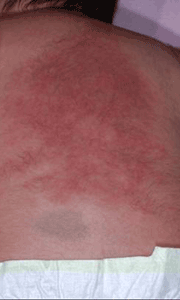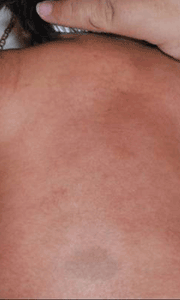A newborn with a firm violaceous plaque on the back
Click Here to Manage Email Alerts
A 2-week-old full term biracial female presents to your office with a 5-day history of an enlarging firm plaque on the back. The plaque was not present at birth and appears to be asymptomatic.

The mother is healthy and had an unremarkable pregnancy. The neonate’s birth history was significant for a difficult vaginal delivery requiring forceps. The neonate otherwise appears healthy and is thriving. On exam, there is a discrete, firm, rectangular 9.5 × 7.5 cm erythematous to violaceous indurated plaque in the middle of her back (Figure 1). The remainder of her physical exam is normal.
What’s Your Diagnosis?
Diagnosis: Subcutaneous fat necrosis of the newborn
Subcutaneous fat necrosis (SCFN) of the newborn is an uncommon skin finding that presents within the first months of life, often in full-term infants. It consists of one or more subcutaneous firm plaques or nodules that resolve spontaneously (Figure 2). On occasion, the cutaneous findings can be associated with hypercalcemia or thrombocytopenia.
The pathogenesis is thought to be related to trauma or other stress during delivery, leading to necrosis in the subcutaneous tissue. In addition, neonatal fat contains a higher ratio of saturated to unsaturated fatty acids, and saturated fatty acids have a higher melting point than unsaturated fatty acids. Therefore, factors such as hypoxia, hypoxemia, hypothermia, hypoglycemia or trauma are thought to lead to crystallization and inflammation of the fat. Interestingly, SCFN was recently reported in a preterm infant treated with whole-body cooling for hypoxic-ischemic encephalopathy. As this therapy is becoming more standard for birth asphyxia, SCFN may become more common.
Clinically, patients present with variably sized single or multiple well-defined skin-colored, erythematous or violaceous, smooth, firm, mobile, subcutaneous nodules or plaques usually located on the cheeks, trunk, buttocks or thighs. They appear within days and up to 4 weeks after birth and resolve over several weeks. Typically, the affected skin heals without scarring, however some patients may develop permanent lipoatrophy.

On histopathology, needle-shaped clefts are found within lipocytes and giant cells surrounded by a mixed infiltrate consisting of neutrophils, lymphocytes and macrophages. There may be foci of necrosis as well.
SCFN can be associated with laboratory abnormalities. Hypercalcemia may develop 1 to 6 months after the cutaneous findings manifest. This is thought to be due to extrarenal production of 1,25-dihydroxyvitamin D3 via activated macrophages expressing 1-alpha hydroxylase in the inflamed fat leading to increased calcium absorption from the gut and resorption from the bone. Symptomatic hypercalcemia should be treated. Thrombocytopenia may also occur and is thought to be due to platelet sequestration in the fat. Hypertriglyceridemia has also been reported. Both thrombocytopenia and hypertriglyceridemia usually resolve concurrently with resolution of the inflammation.

Marissa J. Perman is a third-year dermatolology resident at the University of Cincinnati.
The differential diagnosis includes sclerema neonatorum, a rapid hardening of the subcutaneous tissues seen in premature, medically unstable neonates within the first week of life. These patients often have temperature instability leading to hypothermia with a similar pathogenesis to SCFN. However, the skin findings are usually diffuse, whereas in SCFN, the findings are localized and the patients otherwise appear well. Vascular tumors such as hemangiomas, kaposiform hemangioendotheliomas or tufted angiomas may also be confused with SCFN, especially in patients with darker skin.
History and physical examination are usually sufficient for diagnosis. A biopsy can be obtained for confirmation. Spontaneous resolution is the norm, and no formal therapy is needed. All patients should have a complete blood count and electrolytes to evaluate the platelets and calcium levels respectively. Calcium should be monitored monthly for 6 months. Because the cutaneous findings can be distressing to parents and the associated laboratory abnormalities can be serious, physicians should be familiar with this entity.
Bolognia, Jean L. Dermatology, 2nd edition. Philadelphia: Elsevier, 2008; 1525-1526.
Burden AD. Pediatr Dermatol. 1999;16: 384-387.
Mahé E. Br J Dermatol. 2007;156: 709-715.
Oza V. Arch Dermatol. 2010;146: 882-885.
Photos courtesy of Anne W. Lucky, MD
